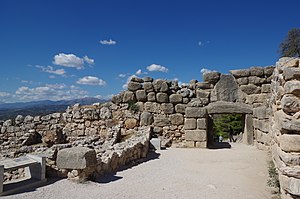
Back Kiklop tikililər Azerbaijani Циклопска зидария Bulgarian Construcció ciclòpia Catalan Kyklopské zdivo Czech Циклопла купалав CV Kyklopisk murværk Danish Zyklopenmauerwerk German Κυκλώπεια τείχη Greek Construcción ciclópea Spanish معماری دیوسنگی Persian

Cyclopean masonry is a type of stonework found in Mycenaean architecture, built with massive limestone boulders, roughly fitted together with minimal clearance between adjacent stones and with clay mortar or[1] no use of mortar. The boulders typically seem unworked, but some may have been worked roughly with a hammer and the gaps between boulders filled in with smaller chunks of limestone. It is similar to Indian masonry such as Cyclopean Wall of Rajgir.
The most famous examples of Cyclopean masonry are found in the walls of Mycenae and Tiryns, and the style is characteristic of Mycenaean fortifications. Similar styles of stonework are found in other cultures and the term has come to be used to describe typical stonework of this sort, such as the old city walls of Rajgir.[2]
The term comes from the belief of classical Greeks that only the mythical Cyclopes had the strength to move the enormous boulders that made up the walls of Mycenae and Tiryns. Pliny's Natural History reported the tradition attributed to Aristotle, that the Cyclopes were the inventors of masonry towers, giving rise to the designation "Cyclopean".[3]
- ^ Fletcher, Banister (1905). A History of Architecture on the Comparative Method (5 ed.). p. 54 – via Internet Archive.
- ^ "The Cyclopean Wall Rajgir". Travel News India. 2017-03-07. Retrieved 2017-03-08.
- ^ Pliny, Hist. Nat.vii.56.195 : turres, ut Aristoteles, Cyclopes [invenerunt].
© MMXXIII Rich X Search. We shall prevail. All rights reserved. Rich X Search